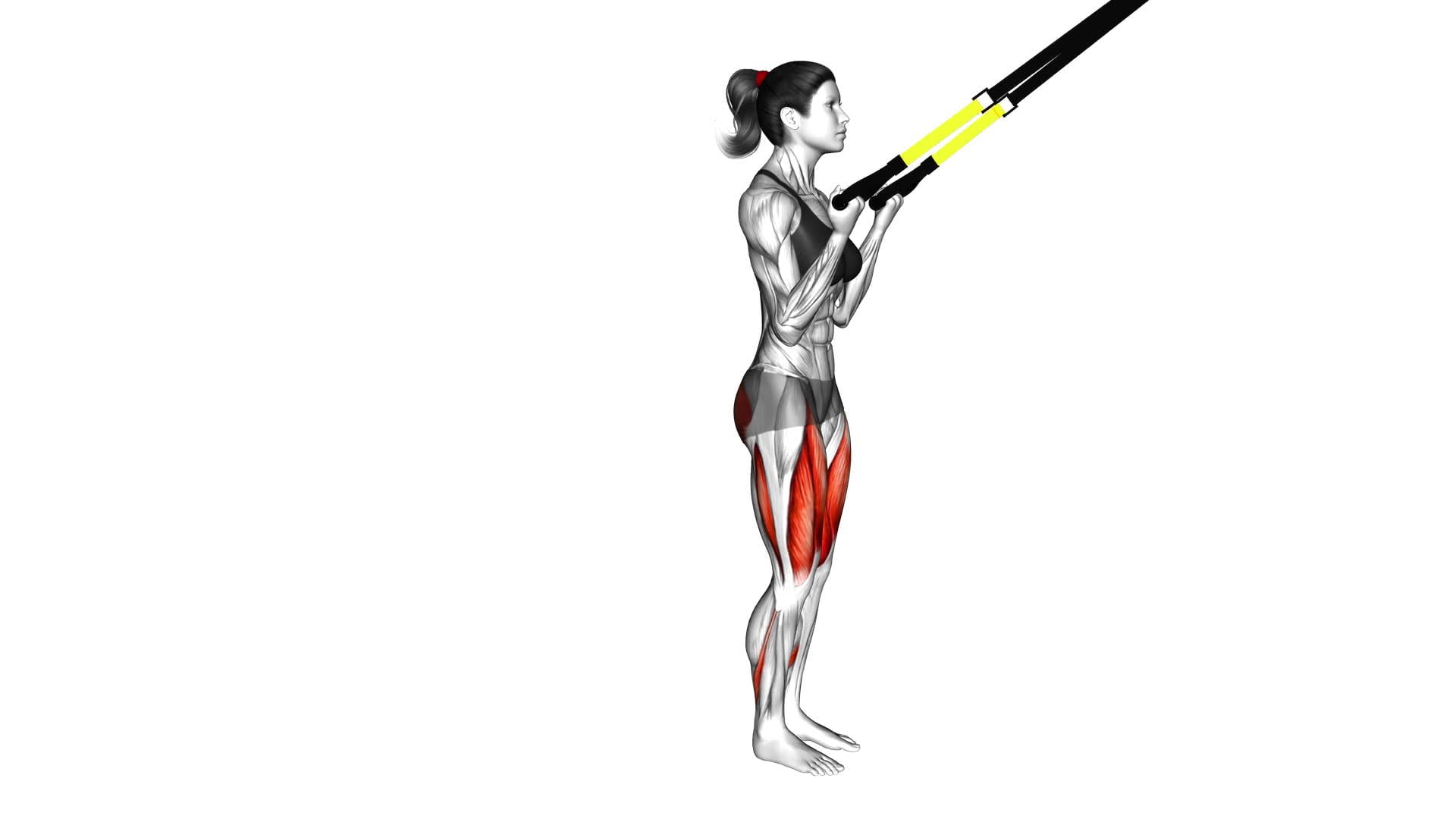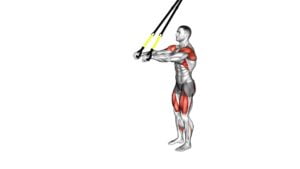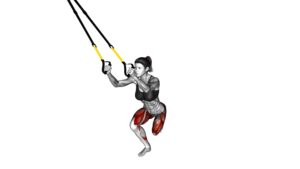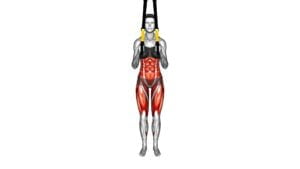Suspender Rear Lunge (female) – Video Exercise Guide & Tips

Get ready to level up your workout routine with the Suspender Rear Lunge. This exercise targets your lower body, specifically your glutes and quads, while also improving your balance and stability.
Watch This Exercise Video
In this video exercise guide, we'll show you the proper form and technique, as well as variations to challenge yourself. Avoid common mistakes and learn tips for incorporating the Suspender Rear Lunge into your fitness regimen.
Let's get started and achieve those fitness goals together!
Key Takeaways
- Targets lower body muscles (glutes, quads)
- Engages multiple muscles (glutes, hamstrings, quads, calves)
- Enhances strength and athletic performance
- Proper form and technique are crucial to maximize benefits and minimize injury risk
Benefits of the Suspender Rear Lunge
You'll reap several benefits when you incorporate the Suspender Rear Lunge into your workout routine. This exercise targets multiple muscles in your lower body, making it a great addition to any leg day. The primary muscles worked during the Suspender Rear Lunge are the glutes, hamstrings, quadriceps, and calves. By engaging these muscles, you can improve your strength and stability, as well as enhance your overall athletic performance.
To progress with the Suspender Rear Lunge, you can increase the difficulty by adding weight or using a suspension trainer. Adding weight can be done by holding dumbbells or a barbell while performing the exercise. This will challenge your muscles even more and help you build strength. Using a suspension trainer, like TRX straps, can also intensify the exercise by forcing you to stabilize your body while performing the lunge.
Incorporating the Suspender Rear Lunge into your workout routine not only targets multiple muscles but also helps improve your balance and coordination. It's a versatile exercise that can be modified to suit your fitness level and goals. Mastering the proper form and technique is crucial to maximize the benefits and minimize the risk of injury. So, let's dive into the next section and learn more about the proper form and technique for performing the Suspender Rear Lunge.
Proper Form and Technique
To perform the Suspender Rear Lunge with proper form and technique, follow these guidelines:
- Maintain proper posture: Keep your chest up, shoulders back, and core engaged throughout the exercise. This will help prevent any unnecessary strain on your lower back.
- Step back with control: When stepping back into the lunge, make sure to do so in a controlled manner. Avoid rushing or using momentum to execute the movement. This will ensure that you engage the correct muscles and maintain balance.
- Keep your knee in line with your ankle: As you lower into the lunge, ensure that your front knee stays aligned with your ankle. Avoid letting it buckle inward or push too far forward, as this can put excessive stress on your knee joint.
Proper execution of the Suspender Rear Lunge is crucial to maximize its benefits and avoid common mistakes. By following these guidelines, you'll target your glutes, quadriceps, and hamstrings effectively while minimizing the risk of injury.
Now that you understand the proper form and technique, let's explore some variations to challenge yourself and take your Suspender Rear Lunges to the next level.
Variations to Challenge Yourself
To challenge yourself and enhance the effectiveness of the Suspender Rear Lunge, incorporate these variations into your workout routine.
Advanced modifications can help you target specific muscle groups and increase muscle activation. One option is to add weights to your hands or wear a weighted vest while performing the exercise. This will increase the resistance and provide a greater challenge for your muscles.
Another variation is the Suspender Rear Lunge with a knee lift. After lunging backward, instead of returning to the starting position, bring your back leg forward and lift your knee towards your chest. This movement engages your core and hip flexors, adding an extra level of difficulty.
Additionally, you can try performing the Suspender Rear Lunge on an unstable surface, such as a Bosu ball or a balance board. This forces your muscles to work harder to maintain stability, further enhancing the challenge.
Remember to always use proper form and technique when attempting these advanced modifications to prevent injury and maximize results.
Keep pushing yourself and enjoy the benefits of a challenging Suspender Rear Lunge workout.
Common Mistakes to Avoid
Avoid these common mistakes when performing the Suspender Rear Lunge to ensure proper form and maximize the effectiveness of the exercise.
To prevent injury and improve balance, keep the following points in mind:
- Maintain proper alignment: Make sure your front knee stays directly above your ankle throughout the movement. This will help prevent unnecessary strain on the joints and reduce the risk of injury.
- Avoid leaning forward: Keep your torso upright and avoid leaning forward when performing the lunge. Leaning forward can put excessive stress on your lower back and compromise your balance.
- Don't rush the movement: Take your time and perform the lunge with control. Avoid rushing or using momentum to complete the exercise. This will allow you to engage your muscles properly and reap the full benefits of the exercise.
By avoiding these common mistakes, you can perform the Suspender Rear Lunge safely and effectively.
Now, let's dive into some tips for incorporating this exercise into your workout routine.
Tips for Incorporating the Suspender Rear Lunge Into Your Workout Routine
To effectively incorporate the Suspender Rear Lunge into your workout routine, start by selecting an appropriate number of repetitions and sets for your fitness level. Lunges are a great exercise for targeting the muscles in your lower body, including your quadriceps, hamstrings, and glutes. By incorporating lunges into your routine, you can improve your lower body strength, stability, and balance.
When incorporating lunges into your workout routine, it's important to focus on proper form and technique. Begin by standing with your feet hip-width apart and your hands on your hips. Take a step backward with one foot, lowering your body until your front knee is bent at a 90-degree angle. Your back knee should hover just above the ground. Push through your front heel to return to the starting position and repeat on the other side.
To maximize the benefits of lunges, consider adding them to your leg day routine. Start with a lower number of repetitions and sets, gradually increasing the intensity as your strength improves. You can also incorporate lunges into a circuit training workout by alternating them with other exercises such as squats or jump lunges.
Remember to listen to your body and adjust the intensity of your lunges as needed. Incorporating lunges into your workout routine can help you build strength, improve balance, and enhance the overall function of your lower body.
Frequently Asked Questions
How Many Sets and Reps Should I Do for the Suspender Rear Lunge?
You should do a suitable rep range for the suspender rear lunge.
This exercise has several benefits, including targeting your glutes, hamstrings, and quads. It also helps improve your balance and stability.
To maximize the benefits, aim for 3-4 sets of 8-12 reps per leg.
Start with a weight that challenges you but allows you to maintain proper form. Gradually increase the weight as you get stronger.
Can I Do the Suspender Rear Lunge if I Have Knee Pain?
If you have knee pain, modifications can be made to the suspender rear lunge to accommodate your needs.
Instead of lunging backward, try stepping backward with one foot at a time while keeping your front knee bent. This reduces the pressure on your knees while still engaging your leg muscles.
Alternatively, you can try other exercises like step-ups or squats, which work similar muscle groups without putting as much strain on your knees.
Is the Suspender Rear Lunge Suitable for Beginners?
The suspender rear lunge can be modified for beginners by reducing the range of motion and using lighter weights. This exercise offers numerous benefits for overall fitness, including strengthening the lower body, improving balance, and increasing flexibility.
It targets multiple muscle groups, such as the quadriceps, hamstrings, and glutes. Incorporating the suspender rear lunge into your workout routine can help you progress and build a solid foundation for more advanced exercises.
Should I Use Weights While Performing the Suspender Rear Lunge?
When performing the suspender rear lunge, you may wonder if using weights is necessary. The answer depends on your fitness level and goals.
Adding weights can increase the intensity and challenge your muscles even more. However, if you're a beginner or have any limitations, it's best to start without weights and focus on mastering the proper form.
As you progress, you can gradually incorporate weights or try modifications to make the exercise more challenging.
How Often Should I Include the Suspender Rear Lunge in My Workout Routine?
To get a well-rounded lower body workout, it's important to incorporate lunges into your routine. The suspender rear lunge is a great exercise to include. It helps strengthen your glutes, hamstrings, and quads while also improving your balance and stability.
To mix things up, try variations like the walking lunge or the side lunge. Aim to include the suspender rear lunge or its variations in your workout routine at least two to three times a week for optimal results.
Conclusion
In conclusion, the Suspender Rear Lunge is a highly beneficial exercise for females looking to strengthen their lower body and improve balance.
By maintaining proper form and technique, individuals can maximize the effectiveness of this exercise.
Additionally, incorporating variations and avoiding common mistakes will help to challenge and push oneself further.
Overall, adding the Suspender Rear Lunge to your workout routine can help you achieve your fitness goals and enhance your overall physical performance.

Author
Years ago, the spark of my life’s passion ignited in my mind the moment I stepped into the local gym for the first time. The inaugural bead of perspiration, the initial endeavor, the very first surge of endorphins, and a sense of pride that washed over me post-workout marked the beginning of my deep-seated interest in strength sports, fitness, and sports nutrition. This very curiosity blossomed rapidly into a profound fascination, propelling me to earn a Master’s degree in Physical Education from the Academy of Physical Education in Krakow, followed by a Sports Manager diploma from the Jagiellonian University. My journey of growth led me to gain more specialized qualifications, such as being a certified personal trainer with a focus on sports dietetics, a lifeguard, and an instructor for wellness and corrective gymnastics. Theoretical knowledge paired seamlessly with practical experience, reinforcing my belief that the transformation of individuals under my guidance was also a reflection of my personal growth. This belief holds true even today. Each day, I strive to push the boundaries and explore new realms. These realms gently elevate me to greater heights. The unique combination of passion for my field and the continuous quest for growth fuels my drive to break new ground.







